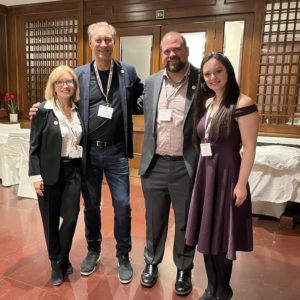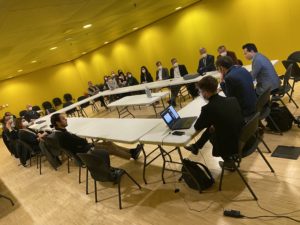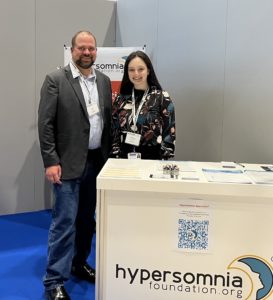SomnusNooze
Frances Smalldridge, a Hypersomnia Foundation volunteer and liaison in the UK, attended the World Sleep conference in March 2022. As a medical student and a person living with a hypersomnia, she learned much about current and future research by connecting with researchers from around the globe and attending presentations. Read on as Frances shares her top take-aways from the conference.
 Diane Powell, Andrew Powell, David Burley, Frances Smalldridge
Diane Powell, Andrew Powell, David Burley, Frances Smalldridge
It was an absolute pleasure to attend the World Sleep Congress in Rome last month with fellow Hypersomnia Foundation representatives David Burley and Diane and Andrew Powell. As a medical student with a central hypersomnolence disorder, I was in my element. Not only did I get to meet other patients and hear their stories, but I had the opportunity to hear from leading researchers and clinicians from around the world about the very latest developments on all things hypersomnia. With ample news to share, I’ve summarised some of my personal top take-aways from the conference.
What’s new in hypersomnia diagnostic protocols?
An important topic of discussion at the conference was how to improve the way doctors diagnose narcolepsy type 1 (NT1), type 2 (NT2) and idiopathic hypersomnia (IH). Currently, the lines between IH and NT2 are blurred because many symptoms are shared between the two groups. In addition, patients with the same diagnosis can have very different symptoms. Researchers also agree that one of the main diagnostic tests, the MSLT (multiple sleep latency test), is so inconsistent that patients who are retested have a 50% chance of losing their diagnosis or being given a different diagnosis.
A group of EU sleep doctors and researchers has proposed a new diagnostic testing protocol (see HF’s article summary) that includes more tests and new ways of separating these hypersomnia diagnoses. While many agree that the new proposal would be an improvement, there are strong concerns because some of the tests needed for diagnosis are not widely available and it is likely that insurance companies in medical systems throughout the world will resist covering the additional tests or accepting the final diagnosis. I will be watching this debate closely over the next few years, as the outcome is likely to have a significant impact on our community.
 Researchers’ Roundtable Discussion
Researchers’ Roundtable Discussion
What are the new biomarkers to help improve diagnosis?
We have strong biomarkers for NT1, particularly low CSF (cerebrospinal fluid) hypocretin/orexin levels, and the ‘narcolepsy gene’ – HLA DQB1 0602. Now researchers are looking for new biomarkers by analyzing the data in our sleep studies to see if there are different patterns of sleep for NT1, NT2, and IH.
Early results of this research have shown that there are different patterns in the types of sleep, called sleep stages, that each group experiences when they first fall asleep. People with IH experience sleep stage NREM1 (light sleep), then NREM2 (a slightly deeper sleep), and then transition to REM sleep (rapid eye movement sleep, when most dreams occur). While 25% of the NT1 group follows this same pattern, 75% do not. They go straight from NREM1 sleep to REM sleep, skipping the NREM2 stage. People with NT2 have a mix of patterns, with 52% experiencing the NREM1 to REM pattern and 48% going from NREM1 to NREM2 to REM like the IH group. Researchers are actively looking at other elements of sleep study data and using advanced analytical techniques to find more patterns that someday could help improve accurate diagnosis.
What are some new questionnaire tools for diagnosis of pediatric hypersomnias?
Narcolepsy and IH symptoms often begin before age 18. Today, most children with hypersomnias do not receive a correct diagnosis for many years. There are several contributing factors to this misdiagnosis, including lack of awareness among healthcare providers and the large overlap of hypersomnia symptoms with those of other disorders (such as attention or behaviour problems, or mental health).
Thankfully, there are now some helpful diagnostic tools, including the Epworth Sleepiness Scale for Children and Adolescents (ESS-CHAD), the Pediatric Narcolepsy Severity Scale (p-NSS), and the newly developed Pediatric Hypersomnolence Screening Tool (Maski, 2022). This new questionnaire does a great job of accounting for symptoms as they may appear to a child or individual with a non-medical background. For example, vivid REM sleep hallucinations often experienced by people with narcolepsy are described as ‘’my dreams seem very real’’. With more awareness of such tools, as well as more pediatric-focused research in the future, hopefully we are moving towards more timely and correct diagnoses.
What’s new in medicines for hypersomnias?
Of course, another important topic presented was medicines for hypersomnia disorders. I especially appreciated some of the comparisons between them, which help target treatment based on the patient’s symptoms, other medical disorders, etc. There are also new upcoming medications which seem promising, such as FT218 (a once-nightly sodium oxybate formulation), TAK925 (an orexin receptor agonist) and Quilience (mazindol ER).
 David Burley and Frances Smalldridge
David Burley and Frances Smalldridge
On the whole, I was happy to see that researchers are very actively working to find more effective treatments. Current management options are far from perfect, and at the moment there are none which are not recommended for discontinuation during pregnancy, which in of itself, has huge implications for anyone heavily reliant on their medication for daily functioning who has any desire to have a family one day. (See HF’s Parenthood and Pregnancy web page for more detailed information.)
So research is as vital as ever, and I am so grateful for every individual who has or is contributing to such research in this field. I enthusiastically anticipate hearing the future findings of the global research community at the next World Sleep conference in September 2023.
